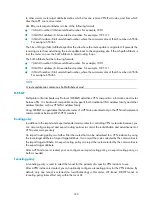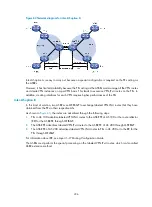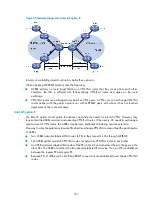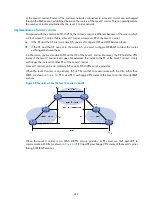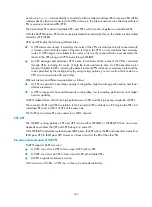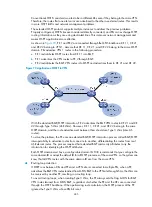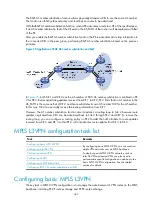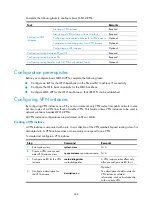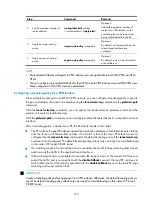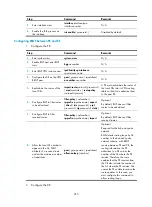
243
As shown in
, devices directly connected to CEs are called underlayer PEs or user-end PEs (UPEs),
whereas devices that are connected with UPEs and are in the internal network are called superstratum
PEs or service provider-end PEs (SPE).
The hierarchical PE consists of multiple UPEs and SPEs, which function together as a traditional PE.
With the HoVPN solution, PE functions are implemented hierarchically. Hence, the solution is also called
hierarchy of PE (HoPE).
UPEs and SPEs play the following different roles:
•
A UPE allows user access. It maintains the routes of the VPN sites that are directly connected with
it, It does not maintain the routes of the remote sites in the VPN, or only maintains their summary
routes. A UPE assigns inner labels to the routes of its directly connected sites, and advertises the
labels to the SPE along with VPN routes through MP-BGP.
•
An SPE manages and advertises VPN routes. It maintains all the routes of the VPNs connected
through UPEs, including the routes of both the local and remote sites. An SPE advertises routes
along with labels to UPEs, including the default routes of VPN instances or summary routes and the
routes permitted by the routing policy. By using routing policies, you can control which nodes in a
VPN can communicate with each other.
Different roles mean different requirements, as follows:
•
An SPE is required to have large-capacity routing table, high forwarding performance, and fewer
interface resources.
•
A UPE is required to have small-capacity routing table, low forwarding performance, but higher
access capability.
HoVPN makes full use of both the high performance of SPEs and the high access capability of UPEs.
The concepts of SPE and UPE are relative. In the hierarchical PE architecture, a PE may be the SPE of its
underlayer PEs and a UPE of its SPE at the same time.
The HoPE and common PEs can coexist in an MPLS network.
SPE-UPE
The MP-BGP running between SPE and UPE can be either MP-IBGP or MP-EBGP. Which one to use
depends on whether the UPE and SPE belong to a same AS.
With MP-IBGP, to advertise routes between IBGP peers, the SPE acts as the RR and advertises routes from
IBGP peer UPE to IBGP peer SPE. However, it does not act as the RR of the other PEs.
Recursion and extension of HoVPN
HoVPN supports HoPE recursion:
•
A HoPE can act as a UPE to form a new HoPE with an SPE.
•
A HoPE can act as an SPE to form a new HoPE with multiple UPEs.
•
HoVPN supports multi-level recursion.
With recursion of HoPEs, a VPN can, in theory, be extended infinitely.


